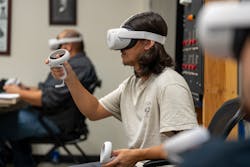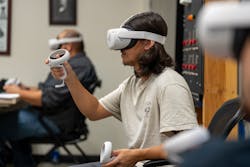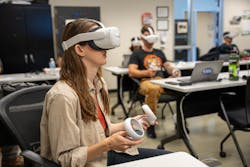How VR Tools Help Train Electrical Apprentices in BESS Inspection Skills
Aiming to improve learning, connect with digital natives, and get a foothold on visualization technology’s cutting edge, Western Electrical Contractors Association (WECA) is making an introductory bet on a virtual reality (VR) tool as an electrical skills training aid.
The group, which serves 300 merit shop electrical contractors in California, Arizona, and Utah with worker training programs and advocacy, has begun using a VR gaming app to help teach apprentices about commercial battery energy storage systems (BESS).
Apprentices in WECA’s commercial electrical program use the VR app to simulate a BESS pre-commissioning inspection. It effectively tests them on BESS knowledge imparted through traditional instruction in the power generation and distribution component of the comprehensive apprenticeship curriculum. Using VR headsets, apprentices walk through a mock inspection, locating specific components, completing checklist tasks, and answering questions that quiz them on their understanding of applicable code regulations.
Early indications are that the VR app (introduced in September and utilized by some six dozen apprentices through early November) is living up to expectations that it would improve the learning process. On one objective measure, test scores for the VR component of the BESS training are averaging higher than those for the two that precede it, says Michelle Gilkey, WECA’s chief growth and innovation officer. Additionally, all who’ve used it have passed, demonstrating skill and understanding. More importantly, perhaps, there’s anecdotal evidence that it delivers on a twin goal of blending measures of non-traditional learning and serious, high-quality instruction.
“Our instructors have reported that they’ve observed students having greater engagement with the material as well as greater retention of component names, layout, and wiring after completing the VR simulations,” she says. “Apprentices who have had real world BESS experience prior to the class have reported that the VR simulation is accurate and realistic, and students who have not yet had BESS work in the field have mentioned that it helps them visualize what they may encounter in the near future.”
With the VR app successfully tested and now fully integrated into BESS training apprenticeship programs at five training centers, WECA will be looking for opportunities to expand on its vision for enhancing training with a fuller spectrum of extended reality (XR) tools. Suspecting that XR will markedly improve/expand training and aid recruitment of young, tech-engaged apprentices, WECA hopes to deliver on its board of directors’ commitment to “developing industry-leading advanced learning technologies focused on XR experiences to bring exciting, remote, and complex environments into WECA’s hands-on labs and classrooms,” Gilkey says.
That expansion would be guided by in-house instructional design teams, as well as member contractors and commercial partners like Canadian VR application developer Motive.io, which provided the content and technology expertise to get the VR app for BESS off the ground. Work is underway now, Gilkey says, on developing a VR tool for confined spaces safety training spanning the full apprenticeship curriculum; expanding the scope of VR in the BESS training; and developing an augmented reality-based lesson to complement enhancements to the data room lab portion of the low-voltage curriculum.
“The safety piece is big, just taking the potential risk out of the training equation, not having the hands-on lab part of this where you could get hurt,” he says, adding that VR could find application in training installers of solar systems, a market Helix is developing that will increasingly demand well-trained installers who can learn comprehensively in a safe environment.
But the priority for any training enhancement, he says, must remain efficiently and effectively delivering the knowledge that translates to skill in the field, and VR could be a silver bullet in that regard. That, too, is the priority of WECA as it moves ahead on the XR front, says Gilkey.
“We have a guiding principle in our XR development — we never seek to add technology just for technology’s sake,” she says. “Rather, we add it only when it allows us to go beyond physical lab limitations to truly expand our apprentices’ learning experience opportunities.”


